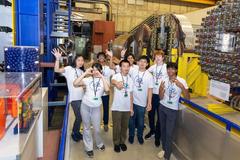The 2024 winners of BL4S at DESY came from the United States. Image: DESY, Marta Mayer
The project “Beamline for Schools” has been turning high school students into temporary scientists for more than ten years. It’s a project of records and firsts: more than 20 000 students between the ages of 16 and 19 from all over the world have come in touch with it over the course of its existence. So far, 25 teams of students have actually performed their experiments at a real beamline at a real physics lab. The High Energy and Particle Physics Division of the European Physical Society EPS awards the project with this year’s EPS Outreach prize “for its original, innovative and successful outreach program of global competitions for high-school teams,” the EPS announced today.
Beamline for Schools (BL4S) a science competition run by the European laboratory for particle physics CERN in cooperation with the German research centre DESY. It is open to secondary school pupils from all around the world. Their task is to come up with an idea for a scientific experiment that can be made at the beamline of a particle accelerator and convince an international jury in order to win a trip to either CERN or DESY. They have to form a team, design the experiment together and submit two proposals: one written, one as a one-minute video. This year’s competition has seen a record number of submissions by 508 teams from 72 countries.
BL4S was launched in 2014 for CERN’s 60th anniversary. After the success of the first edition, the competition continued and the number of participants is steadily increasing. The BL4S collaboration between CERN and DESY began in 2019, when CERN’s accelerators were shut down for maintenance. DESY has hosted a team every year ever since. This year sees another two firsts: DESY will be able to host two teams and one more team will be invited to perform their experiment at the accelerator ELSA at the University of Bonn.
The different divisions of the European Physical Society EPS hand out a number of prizes for outstanding projects or individuals every year. The High Energy and Particle Physics Division’s Outreach Prize is one of them and consists of a diploma specifying the work of the recipients, as well a cash amount. The appraisal highlights the unique nature and reach of BL4S: “The 2025 Outreach Prize of the High Energy and Particle Physics Division of the EPS is awarded to the Beamline for Schools Project for its original, innovative and successful outreach program of global competitions for high-school teams, offering the winning teams the unique opportunity to carry out their proposed experiments at major particle physics accelerator laboratories such as CERN or DESY.”
“I am delighted that this prize recognizes this fantastic project that was made possible by many dedicated colleagues from DESY and CERN,” says Beate Heinemann, Chair of the Board of Directors at DESY. “Beamline for schools encourages school kids to develop their own ideas and enables them to test them: that is the essence of science. Being able to do this at world-class research institutes changes their lives – and seeing their excitement about science is very inspiring and gives me hope for the Future.”
“This is a huge honour for the many individuals who have contributed to the success of the BL4S programme over the past 11 years,” says project leader Jorge Andres Villa Velez (CERN). “In BL4S we create an environment for high school students that resembles as much as possible the environment in which professionals do their research. This unlocks an enormous amount of curiosity, self-motivated learning and creativity among the students.”
The 2025 Beamline for Schools Competition is sponsored via the CERN and Society Foundation, with support from the Wilhelm and Else Heraeus Foundation, Rolex, and anonymous sponsors.








